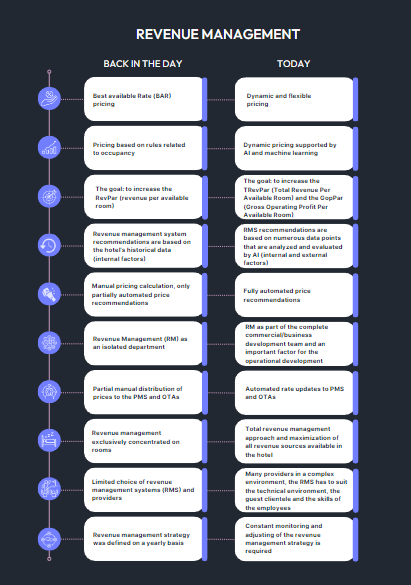Hopefully, you won't find anyone who misses spending their time collecting and integrating endless data scattered across multiple data silos. Or creating macros to perform calculations in massive Excel spreadsheets. Or constantly logging into the various platforms to view relevant data. Or sifting through mountains of data in search of inconsistencies or input errors. Or manually checking forecasts in the hope of finding opportunities to improve pricing.
Technological innovations have made all these tedious and cumbersome tasks that were part and parcel of the revenue management routine almost redundant. New technology solutions are relieving revenue managers of both repetitive and complex tasks, freeing them from daily manual data collection, entry, analysis, and updating. This allows them to concentrate on the most important, the strategic part of the role.
But then, what does it even mean to be a revenue manager these days? The role is redefining itself and is now about developing high-value, holistic strategies that serve to optimize financial performance across all areas of the business.
Thanks to artificial intelligence (AI) and machine learning, the science of price optimization can now largely run on autopilot. Today's best solutions adapt to dynamic markets in real time, coping beautifully with the complexity of modern markets.
A look back shows clear differences between the traditional approaches from the past and the innovative strategies of today:

- * RevPar: Revenue per available Room
- ** TRevPar: Total Revenue per available Room
- *** GopPar: Gross operating profit per available room
AI makes it possible to accurately predict not only how many guests will check into a hotel at a given time (often months in the future) but also what type of guests they will be, what kind of rooms they will request, what maximum rate they will pay and how much they will spend during their stay at the hotel.
An AI-powered revenue management solution is usually more accurate in its predictive capabilities and can react much faster to unexpected situations than traditional RMS systems. Although such a solution incorporates historical data, this is not the primary data for price recommendations but instead countless other external factors (weather, events, demand, reputation, supply, etc.). In the past, these factors also influenced both demand and price. However, due to the high level of complexity caused by continuous change, they could not be incorporated into manual pricing. After all, revenue managers already had their hands full with other data collection and analysis. However, today's competitive pressure makes it crucial to see the holistic picture and act accordingly.

